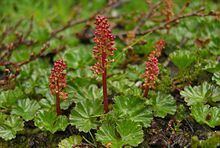Scientific name Gunnera magellanica | Genus Gunnera Rank Species | |
 | ||
Similar Gunneraceae, Gunnera, Chilean rhubarb, Gunnera hamiltonii, Gunnerales | ||
Gunnera magellanica is a perennial rhizomatous dioeceous herb native to Chile, Argentina and the Falkland Islands, and Andean areas of Peru, Ecuador. In the southern part of its range it grows in damper parts of the Magellanic Forests, and shrub formations on Tierra del Fuego, with an altitudinal range from sea level to 1500m.
Contents
Description
Unlike its congeners, G. tinctoria and G. manicata, the leaves are small, approximately 6 cm across. They are rounded or kidney-shaped, stipulate on long (2–10 cm) petioles, with crenate edges.
Flowers are unisexual, with female inflorescences shorter than male ones. The fruit is a bright red berry (drupe) 3–5 mm in diameter.
The leaves die back in the austral autumn, so G. magellanica perennates as under-ground rhizomes,and is therefore classified as a cryptophyte.
Taxonomy
Gunnera magellanica was first described Jean-Baptiste Lamarck in Encyclopédie Méthodique, Botanique 3: 61, t. 801, f. 2. 1789.
Gunnera: the generic name honours the Norwegian botanist and bishop Johan Ernst Gunnerus.
magellanica: geographical epithet referring to its distribution in proximity to the Magellan Straits.
Vernacular Names
Vernacular names are Frutilla del Diablo in Spanish, and in English on the Falkland Islands it is called Pigvine or Pig Vine.
Garden Plant
Gardeners in English-speaking countries know it as Baby Gunnera, Devil's Strawberry (probably a direct translation of the Spanish name) or Dwarf Rhubarb. As a garden plant G. magellanica can be used as ground cover, but is sometimes invasive. It rarely fruits as it is dioecous and both male and female plants are needed.
Stamps
G. magellanica featured on the 1½ d. stamp of the 1968 "Floral Issue" of Falkland Island postage stamps.
